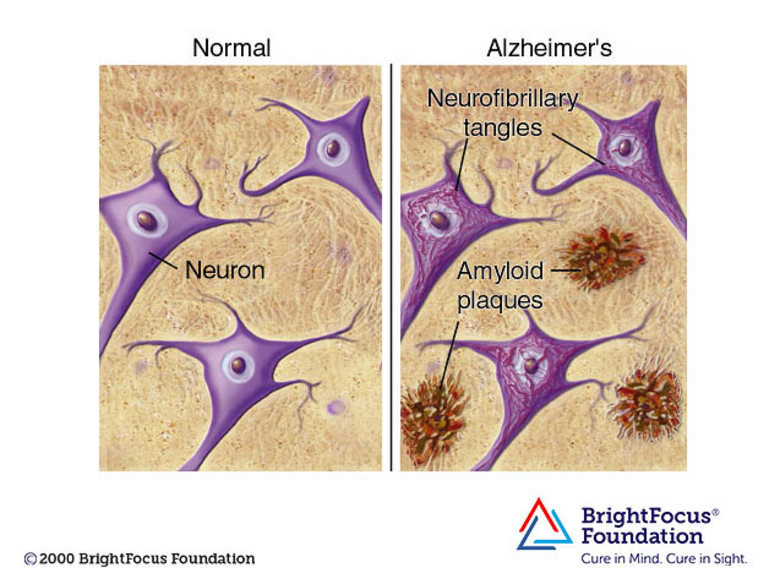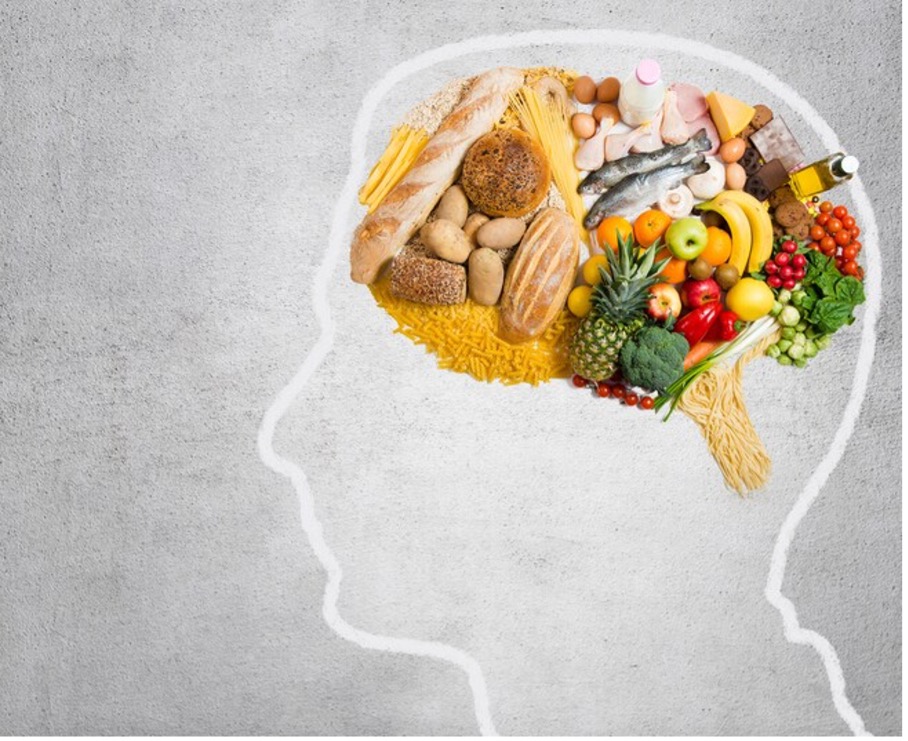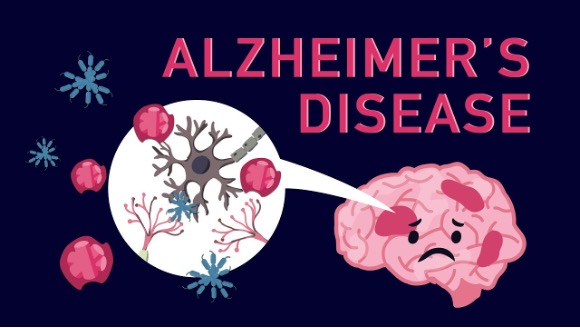Figure 1: Alzheimer’s disease[1]
Alzheimer’s disease (AD) is one of the most common diseases related to decline in cognitive abilities, but at the same time its causes and hallmarks might be unknown to most people. AD is a gradual and progressive neurodegenerative disorder, which tends to affect the older population. Deficits related to this disorder is such of memory, language, attention, reasoning, comprehension, and judgement[2]. Generally, the decline in cognitive abilities can be defined by the term dementia, however, AD is the most common type of dementia. Pathological AD hallmarks can be categorized as amyloid-β-plaques (clumps of beta amyloid protein) and neurofibrillary tangles (bundles of tangles made up by tau protein) that develops in the brain[3]. A neuromodulator in the brain that has been revealed to be one of the factors of cognitive impairment and the AD pathology is dysregulated brain insulin signaling[4].
 Figure 2: The comparison of a normal brain versus the AD brain, with the formations of neurofibrillary tangles and amyloid plaques. [5]
Figure 2: The comparison of a normal brain versus the AD brain, with the formations of neurofibrillary tangles and amyloid plaques. [5]
The progression of AD can be seen as a process with many implication factors, as understood with the implications with insulin signaling, but the process of AD is related to some precursors that can start already at the level of healthy eating patterns. Studies have found that a healthy diet is associated with a lower risk of AD[6]. A list of nutrients has been found to have a beneficial effect on the course of AD, such as vitamins B6, B12, folic acid, polyphenols, while on the other hand for example fatty acids promotes the progression of the disease[7]. Additionally, a study found that plant-based diets such as the Mediterranean diet, were associated with lower levels of oxidative stress and inflammation in comparison to a fast-food diet[8]. Healthy diets can be believed to affect underlies mechanisms such as oxidative stress and neuroinflammation[9], which further play a role in influencing pathways, the formation of plaques, and neural death[10]. The formation of plaques (tau accumulation) and neural death contribute to the formation of tangles inside the neurons which is a part of the progression of AD.
 Figure 3: The impact of nutrition on the brain. [11]
Figure 3: The impact of nutrition on the brain. [11]
In relation to both healthy lifestyle and impaired insulin signaling is diabetes type 2, which is a result of both of these. It has been found that people who suffer from diabetes type 2 have a higher likeliness for the progression of AD, because of the strong correlation[12]. So, the process starting at the food one consumes, can play are role in the progression of AD, and the different precursors and factors that play a role in the progression of AD. As can be seen with the interconnecting pathological features of neuroinflammation and insulin resistance that are two of the major factors of synaptic disruption and neurogenerative processes[13]. Diabetes connects with the insulin resistance, and nutrition play are role in the development of diabetes type 2 and neuroinflammation, which can all be tied to the progression of AD.
A big factor with Alzheimer’s disease is time, since there is no cure or treatment that will heal the disease, we are looking for options to give Alzheimer’s patients a longer time to live, maybe even a better quality of life. One of these options can be understood to be nutrition, and your lifestyle. Therefore, interventions should or could be implied as early as possible to minimize the development of the disease. By looking at small bits of the progression of this disease, hopefully we are slowly understanding more on how to deal with Alzheimer`s disease.
[1] What is Alzheimer’s Disease? (n.d.). YouTube. https://www.google.com/url?sa=i&url=https%3A%2F%2Fwww.youtube.com%2Fwatch%3Fv%3D7F-t9yvPP_0&psig=AOvVaw01G76eZhQmR8VmBscxeREB&ust=1707882712431000&source=images&cd=vfe&opi=89978449&ved=0CBMQjRxqFwoTCMDYuYa1p4QDFQAAAAAdAAAAABBV
[2] Kumar, A., Sidhu, J., Goyal, A., et al. Kumar, A. (2022, June 5). Alzheimer Disease. StatPearls – NCBI Bookshelf. https://www.ncbi.nlm.nih.gov/books/NBK499922/
[3] What happens to the brain in Alzheimer’s disease? (n.d.). National Institute on Aging. https://www.nia.nih.gov/health/alzheimers-causes-and-risk-factors/what-happens-brain-alzheimers-disease
[4] Akhtar, A., & Sah, S. P. (2020). Insulin signaling pathway and related molecules: Role in neurodegeneration and Alzheimer’s disease. Neurochemistry International, 135, 104707. https://doi.org/10.1016/j.neuint.2020.104707
[5] Amyloid Plaques and Neurofibrillary tangles | BrightFocus Foundation. (2015, July 1). https://www.brightfocus.org/news/amyloid-plaques-and-neurofibrillary-tangles
[6] Hu, N., Yu, J. T., Tan, L., Wang, Y. L., Sun, L., & Tan, L. (2013). Nutrition and the risk of Alzheimer’s disease. BioMed research international, 2013, 524820. https://doi.org/10.1155/2013/524820
[7] Śliwińska, S., & Jeziorek, M. (2021). The role of nutrition in Alzheimer’s disease. Roczniki Panstwowego Zakladu Higieny, 72, 29–39. https://doi.org/10.32394/rpzh.2021.0154
[8] Aleksandrova, K., Koelman, L., & Rodrigues, C. E. (2021). Dietary patterns and biomarkers of oxidative stress and inflammation: A systematic review of observational and intervention studies. Redox Biology, 42, 101869. https://doi.org/10.1016/j.redox.2021.101869
[9] Aleksandrova, K., Koelman, L., & Rodrigues, C. E. (2021). Dietary patterns and biomarkers of oxidative stress and inflammation: A systematic review of observational and intervention studies. Redox Biology, 42, 101869. https://doi.org/10.1016/j.redox.2021.101869
[10] Akhtar, A., & Sah, S. P. (2020). Insulin signaling pathway and related molecules: Role in neurodegeneration and Alzheimer’s disease. Neurochemistry International, 135,104707. https://doi.org/10.1016/j.neuint.2020.104707
[11] What we know about Alzheimer’s disease and nutrition. (n.d.). Nutri-facts. https://www.nutri-facts.org/en_US/news/articles/what-we-know-about-alzheimers-disease-and-nutrition.html
[12] Akhtar, A., & Sah, S. P. (2020). Insulin signaling pathway and related molecules: Role in neurodegeneration and Alzheimer’s disease. Neurochemistry International, 135,104707. https://doi.org/10.1016/j.neuint.2020.104707
[13] Ibid.
